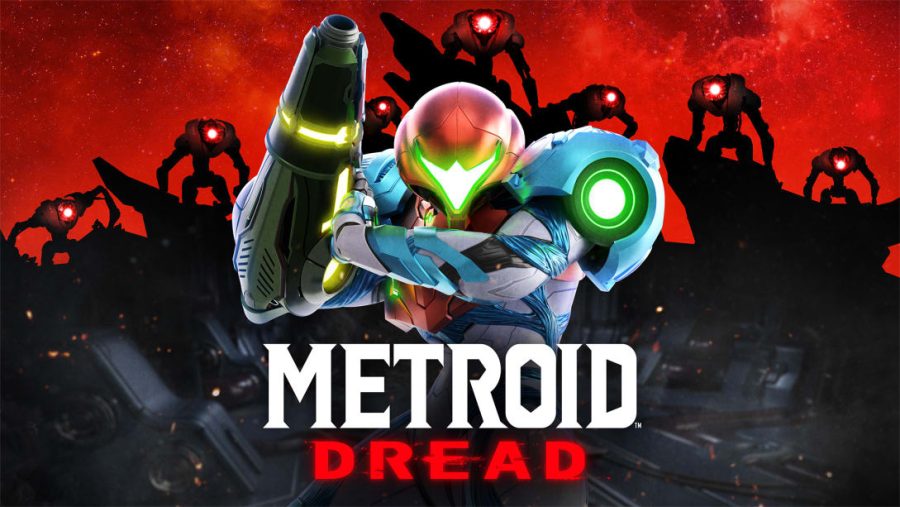Release of “Metroid Dread” is monumental step for Nintendo, revival of the timeless “Metroid” series
February 1, 2022
Samus Aran, the alien bounty hunter, was attacked by the X-Parasite, a lethal alien species, on the planet SR388. The X-Parasite is the predator of the Metroid, another alien species Samus is known to have purged from existence. Samus believes the X-Parasite to be extinct after fighting in a culminating battle at the end of the Metroid Fusion series. However, Samus has recently received footage of a living X-Parasite on the planet ZDR, and in acknowledgement of her duty as a bounty hunter, Samus decides to travel to ZDR to find out the truth for herself. Upon arrival, however, before she is able to gain truth, Samus is attacked by a mysterious creature and is cast into the depths of the planet, completely stripped of her powers and trapped in the complex of the unknown. Her new objective is to escape alive.
This is the premise of the newest Metroid game, “Metroid Dread,” appearing miraculously after 19 years since the release of “Metroid Fusion.” The game is a direct continuation of Fusion and was scheduled to be released on the DS by Yoshio Sakamoto, somehow scrapped and lost among other developments. The idea was recovered by developer MercurySteam, who is known for creating the remake, “Metroid 2: Return of Samus.”
“Metroid Dread” is essentially non-linear, meaning the game leads players to become lost and is sort of open-world, allowing Samus the exploration of nine sectors—Artaria, Cataris, Dairon, Burenia, Ghavoran, Ferenia, Elun, Hanubia and Itorash—all of which unlock as the game progresses and Samus locates the area in question. The game prevents players from reaching certain areas by hidden blocks, which can be destroyed by various means, some unavailable in the early stages of the game due to the lack of sufficient equipment and powers. The 2D aspect also means lots of platforms and jumping to reach new areas, just as previous Metroids require.
The gameplay relating to controls is very similar to the Metroid 2 remake by MercurySteam, but contains some subtle changes. Samus is given the new “slide” ability by pressing ZL while in motion, which replaces the morph ball until it is retrieved by Samus in later gameplay. There is also a free aim feature triggered when holding L, present in the Metroid 2 remake. The Metroid 2 remake also featured a melee counter ability, finding a reappearance in “Dread,” as Samus can use this move while moving and stationary to counter an enemy attack. This new move provides knockback and dealt damage, netting Samus ammo and more health. The rest of the controls are relatively similar to classic Metroid games; movement is with the left stick, jump is with B, shoot with Y and holding R allows for missiles. Along with the continuities of controls, the game features a lot of the same audio as the original Metroid games such as the powerup sound.
Other similarities that “Metroid Dread” features in correspondence to past Metroids are the many bosses. These are spaced plentifully throughout the world of the game and players will find themselves dying many times before achieving victory. The main bosses contain attack patterns and phases of attack as classic bosses did, but there is the incorporation of the Extraplanetary Multiform Mobile Identifier (E.M.M.I.) robots to add some extra flair, as players cannot defeat these and are forced to flee. The encounter with these terminator-like robots is unavoidable, as the sectors the E.M.M.I. are present in are directly between Samus and the location she wishes to reach, though players will not encounter them too often, as the world is expansive enough to contain nine spaced-out E.M.M.I. zones. “Dread” is similar to past Metroids in its difficulty factor as well, causing players to map out the world of the game while getting lost frequently and attempting to remember previous exploration efforts that were unsuccessful due to lack of equipment.
Considering “Metroid Dread”’s continuities in classic components and answer to the Metroid fanbase’s want for a new game continuing off of the past success of Metroid Fusion, this game screams fan-friendliness and satisfies long-time Metroid fans. Now that the Metroid itch is temporarily pacified, fans will not have to wait long before their hopes are again confirmed. In 2022, “ Metroid Prime 4” is on the horizon for Nintendo, an even further excitement for Metroid enthusiasts as it is yet another continuation of a well-loved Metroid line, the Metroid Prime series.
Have you given “Metroid Dread” a try? If so, what are your thoughts on it? Let us know in the comments below.


















































































